Study on Fracture Behavior of Directly Covered Thick Hard Roof Based on Bearing Capacity of Supports
Abstract
:1. Introduction
2. Motivation and Novelties
3. Project Overview and Pressure Control Analysis of a Directly Covered Thick
Hard Roof
4. Analysis of Mining Instability of Roof Cut Falling Structure
4.1. Physical Form of Cut Falling Body of Directly Covered Thick Hard Roof
4.2. Analysis of the Bearing Capacity of the Roof Cut Falling Body—Hydraulic Support

4.3. Factor Analysis of Brace Bearing Performance
- (1)
- The relationship graphs between the aforementioned six indicators and F show that the stent resistance will increase with the length of the broken body following pre-cracking and top cutting.
- (2)
- Figure 8a–d show that when one of the other factors, such as roof load q0, face length 2a, bracket stiffness K, or the top control distance l, is changed, the result is an increase in support resistance F, proving that all of the other factors are positively correlated with bracket resistance.
- (3)
- The slope of each element in the four graphs (a–d) indicates how sensitive that factor is to the impact of hydraulic support resistance. Working face length is not the primary element that determines the increase in brace resistance for the directly covered thick hard roof working face because the brace resistance responds more visibly to changes in K, l, and q0 while the slope of the change in working face length is flatter.
- (4)
- In Figure 8e,f, the hydraulic support resistance at the working face is negatively correlated with the strength and thickness of the roof rock layer. The required working face bracing resistance will be smaller the stronger and thicker the roof plate is, indicating that the thick hard roof plate bears the overlying rock in addition to its own load on the coal seam within a range, reducing the load acting on the coal seam and the required bracing resistance.
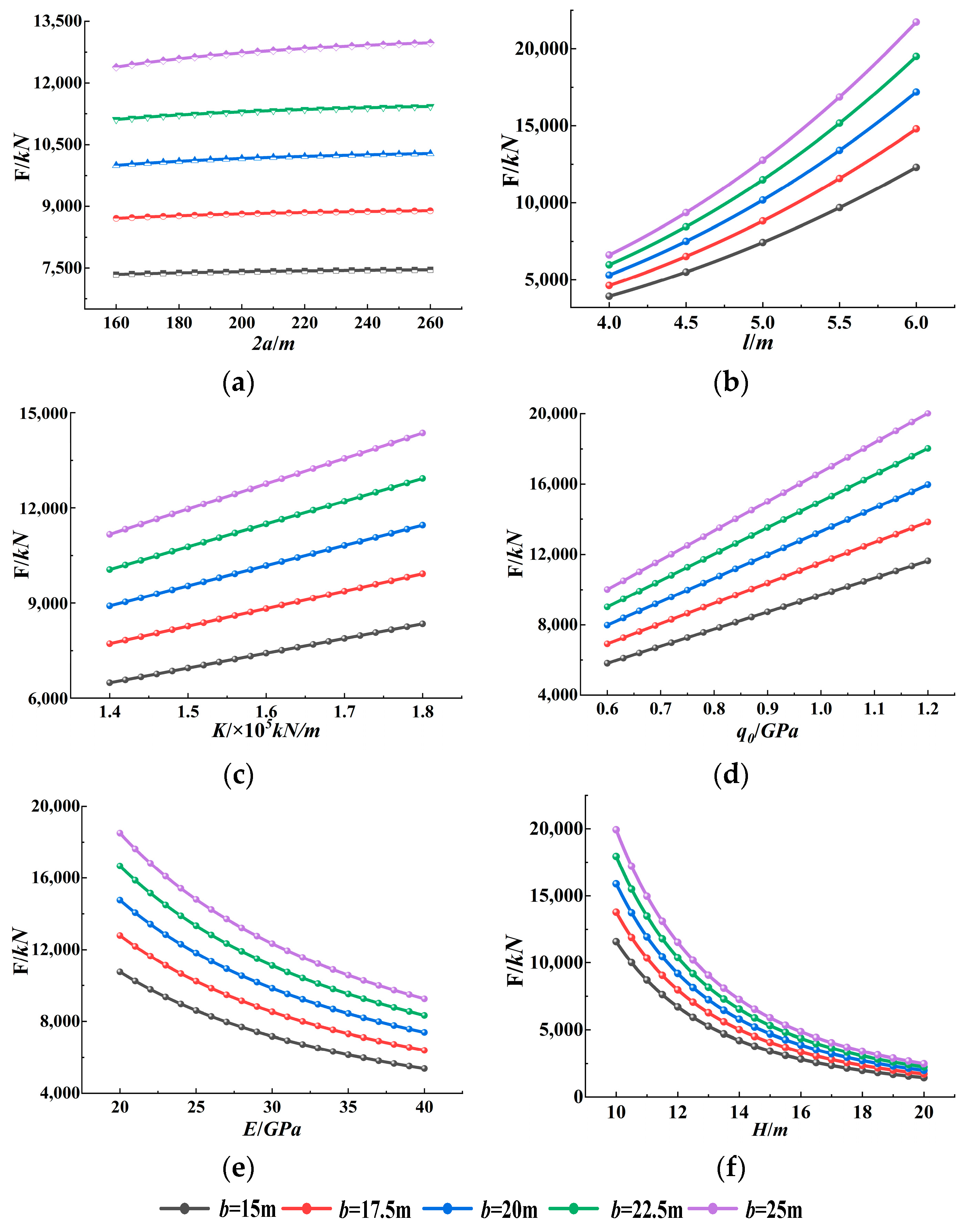
5. Determination and Verification of the Structure Size of the Cutting Block
5.1. Collapse Displacement Analysis
5.2. Stress Analysis
6. Analysis of the Bearing Performance of the Working Face Site Bracket
7. Discussion
8. Conclusions
- (1)
- The directly covered thick hard roof fracture step is too long, which is the main cause of the work surface seeming to have intense ore pressure, according to analysis of the equation of incoming pressure equivalent of the roof plate. For the working face of a thick hard roof plate, using technical means to shorten the pressure step is an effective method for controlling mine pressure at the mining site.
- (2)
- The pre-cracked cut top effectively reduces cantilever length, and the cut fall body is a “simple supported—free” structure, according to modeling investigations using physically similar materials.
- (3)
- A mechanical model of a thick hard roof cut falling body is developed using the plate structure theory, and mechanical analysis is carried out based on how the bracket and roof interact. It was discovered that the hydraulic bracket resistance F of the working face has a negative correlation with the strength E and thickness H of the rock layer and a positive correlation with the working face length 2a, cut falling body length b, control roof distance l, bracket stiffness K, and roof load q0.
- (4)
- The overhanging distance of the thick hard top slab in the mining hollow area can be effectively reduced by 40.15% thanks to pre-cracking roof cutting, which also reduces the stress concentration degree by 31.74% and the overall stress level of the hydraulic bracket by 26.59–28.38%, according to numerical simulation results. This significantly raises the thick hard top slab just above the working face’s incoming pressure intensity.
- (5)
- After cutting the roof, the initial pressure step was 40.8 m, the pressure dynamic load coefficient was 1.43, the cycle step was 19.6 m, the pressure dynamic load coefficient was 1.33, and the hydraulic bracket working resistance was only 0.9% in the pressure bracket hydraulic valve. These measurements are combined with site engineering practice and an analysis of the monitoring results. To meet the demands for safe production at the working face of the Gubei Mine in the situation of a direct covered thick hard roof, the working face chooses the ZZ13000/24/50 support cover type brace with a 20 m step pre-cracking roof cutting.
Author Contributions
Funding
Data Availability Statement
Conflicts of Interest
References
- Wang, G.; Xu, Y.; Ren, H. Intelligent and ecological coal mining as well as clean utilization technology in China: Review and prospects. Int. J. Min. Sci. Technol. 2019, 29, 161–169. [Google Scholar] [CrossRef]
- Zhang, P.; Li, F.; Zhu, H.; Niu, H.; Li, X. Statistical analysis and prevention countermeasures of coal mine accidents from 2008 to 2020. Min. Saf. Environ. Prot. 2022, 49, 128–134. [Google Scholar]
- Mu, L.; Bian, X.; Yang, D. Analysis of the causes and safety management measures of roof accidents in mining engineering. China Met. Bull. 2020, 9, 14–15. [Google Scholar]
- Li, L.; Ouyang, Y. Study on Safety Management Assessment of Coal Mine Roofs Based on the DEMATEL-ANP Method. Front. Earth Sci. 2022, 10, 891289. [Google Scholar] [CrossRef]
- He, Z.; Lu, C.; Zhang, X.; Guo, Y.; Meng, Z.; Xia, L. Numerical and Field Investigations of Rockburst Mechanisms Triggered by Thick-Hard Roof Fracturing. Rock Mech. Rock Eng. 2022, 55, 6863–6886. [Google Scholar] [CrossRef]
- Wang, W.; Cheng, Y.; Wang, H.; Liu, H.; Wang, L.; Li, W.; Jiang, J. Fracture Failure Analysis of Hard-Thick Sandstone Roof and its Controlling Effect on Gas Emission in Underground Ultra-Thick Coal Extraction. Eng. Fail. Anal. 2015, 54, 150–162. [Google Scholar] [CrossRef]
- Ünver, B.; Yasitli, N.E. Modelling of strata movement with a special reference to caving mechanism in thick seam coal mining. Int. J. Coal Geol. 2006, 66, 227–252. [Google Scholar] [CrossRef]
- Zheng, Z.; Xu, Y.; Li, D.; Dong, J. Numerical Analysis and Experimental Study of Hard Roofs in Fully Mechanized Mining Faces under Sleeve Fracturing. Minerals 2015, 5, 758–777. [Google Scholar] [CrossRef]
- Ma, J.; Guan, J.; Duan, J.; Huang, L.; Liang, Y. Stability analysis on tunnels with karst caves using the distinct lattice spring model. Undergr. Space 2020, 6, 469–481. [Google Scholar] [CrossRef]
- Huang, L.; Ma, J.; Lei, M.; Liu, L.; Lin, Y.; Zhang, Z. Soil-water inrush induced shield tunnel lining damage and its stabilization: A case study. Tunn. Undergr. Space Technol. 2020, 97, 103290. [Google Scholar] [CrossRef]
- Ma, J.; Chen, J.; Chen, W.; Huang, L. A coupled thermal-elastic-plastic-damage model for concrete subjected to dynamic loading. Int. J. Plast. 2022, 153, 103279. [Google Scholar] [CrossRef]
- Zheng, K.; Zhang, T.; Zhao, J.; Liu, Y.; Yu, F. Evolution and management of thick-hard roof using goaf-based multistage hydraulic fracturing technology—A case study in western Chinese coal field. Arab. J. Geosci. 2021, 14, 876. [Google Scholar]
- Tang, J.; Liu, H.; Chen, A. Experimental Study on Presplitting Blasting of Roof Cutting Along Goaf with Thick and Hard Roof Plate. IOP Conf. Ser. Earth Environ. Sci. 2021, 692, 022089. [Google Scholar] [CrossRef]
- Zhang, C.; Zou, J.; Zhang, X.; Wang, C.; Jiao, Y. Study on the Mechanism of Weakening Thick and Hard Roof by Deep-Hole Blasting in Deep Coal Mines. Front. Earth Sci. 2022, 10, 933192. [Google Scholar] [CrossRef]
- Chen, B.; Liu, C.; Wang, B. A case study of the periodic fracture control of a thick-hard roof based on deep-hole presplitting blasting. Energy Explor. Exploit. 2022, 40, 279–301. [Google Scholar] [CrossRef]
- Chen, B.; Liu, C. Analysis and Application on Controlling Thick Hard Roof Caving with Deep-Hole Position Presplitting Blasting. Adv. Civ. Eng. 2018, 2018, 9763137. [Google Scholar] [CrossRef]
- Xu, J.; Pu, H.; Sha, Z. Mechanical behavior and decay model of the sandstone in Urumqi under coupling of freeze–thaw and dynamic loading. Bull. Eng. Geol. Environ. 2021, 80, 2963–2978. [Google Scholar] [CrossRef]
- Zhao, C.; Liu, J.; Lyu, C.; Chen, W.; Li, X.; Li, Z. Experimental study on mechanical properties, permeability and energy characteristics of limestone from through-coal seam (TCS) tunnel. Eng. Geol. 2022, 303, 106673. [Google Scholar] [CrossRef]
- Wang, G.; Pang, Y. Relationship between hydraulic support and surrounding rock coupling and its application. J. China Coal Soc. 2015, 40, 30–34. [Google Scholar]
- Wang, G.; Pang, Y. Shield-roof adaptability evaluation method based on coupling of parameters between shield and roof strata. J. China Coal Soc. 2016, 41, 1348–1353. [Google Scholar]
- Miao, X.; Qian, M. Overall mechanical model and analysis of the surrounding rock—Support in a header mining site. Coal 1998, 6, 1–5+13. [Google Scholar]
- Qian, M.; Miao, X.; He, F.; Liu, C. Study on the mechanism of coupling action between quarry support and surrounding rock. J. China Coal Soc. 1996, 1, 40–44. [Google Scholar]
- Xu, Y.; Wang, G.; Ren, H. Theory of the coupling relationship between surrounding rocks and powered support. J. China Coal Soc. 2015, 40, 2528–2533. [Google Scholar]
- Wang, D.; Zeng, X.; Wang, G.; Li, R. Adaptability Analysis of Four-Leg Hydraulic Support with Large Mining Height under Impact Dynamic Load. Shock Vib. 2022, 2022, 2168871. [Google Scholar] [CrossRef]
- Marcin, W.; Stanisław, P. Numerical calculations of shield support stress based on laboratory test results. Comput. Geotech. 2016, 72, 74–88. [Google Scholar]
- Qian, M.; Xu, J.; Wang, J. Mine Pressure and Rock Control, 3rd ed.; China University of Mining and Technology Press: Xuzhou, China, 2021; pp. 121–158. [Google Scholar]
- Li, J.; Fu, B. Pressure relief technology of thick hard sandstone directly covering roof. Coal Eng. 2022, 54, 101–107. [Google Scholar]
- Xu, Y.; Wang, G. Supporting principle and bearing characteristics of hydraulic powered roof support groups. Chin. J. Rock Mech. Eng. 2017, 36, 3367–3373. [Google Scholar]
- Xu, Z. Elasticity(Volume II), 5th ed.; Higher Education Press: Beijing, China, 2016; pp. 68–76. [Google Scholar]
- Xu, Y.; Wang, G.; Zhang, J.; Ren, H.; Li, D. Theory and Application of Supporting Stress Fields of Hydraulic Powered Support Groups in Fully mechanized Mining Face with Large Mining Height Based on Elastic Supporting Beam Model. Chin. J. Rock Mech. Eng. 2018, 37, 1226–1236. [Google Scholar]
- Chen, S.; He, M.; Guo, Z.; Yang, H.; Yang, J. Control Countermeasures of Surrounding Rock in Deep Gob-Side Entry Retaining by Cutting Roof. Adv. Eng. Sci. 2019, 51, 107–116. [Google Scholar]

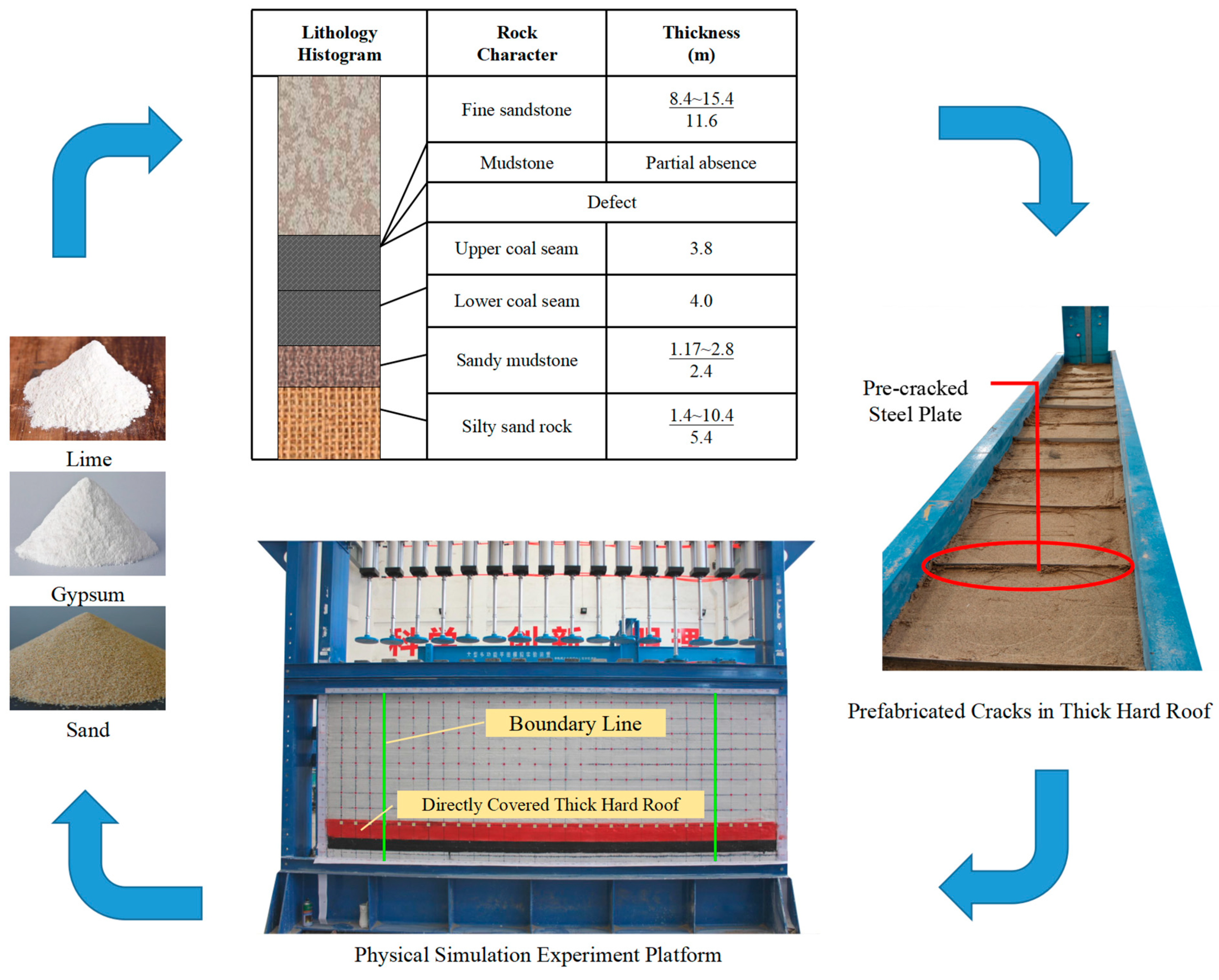

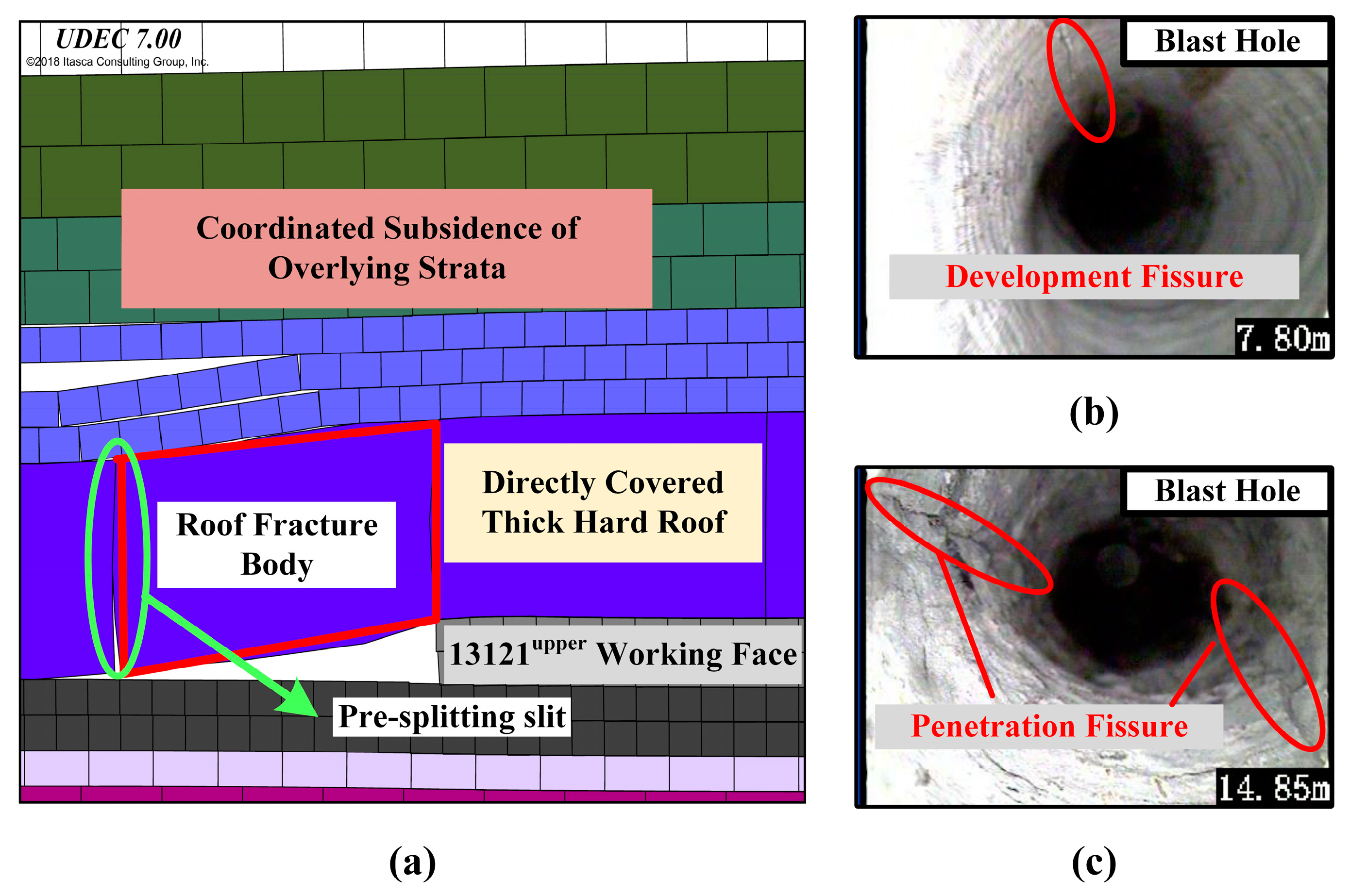





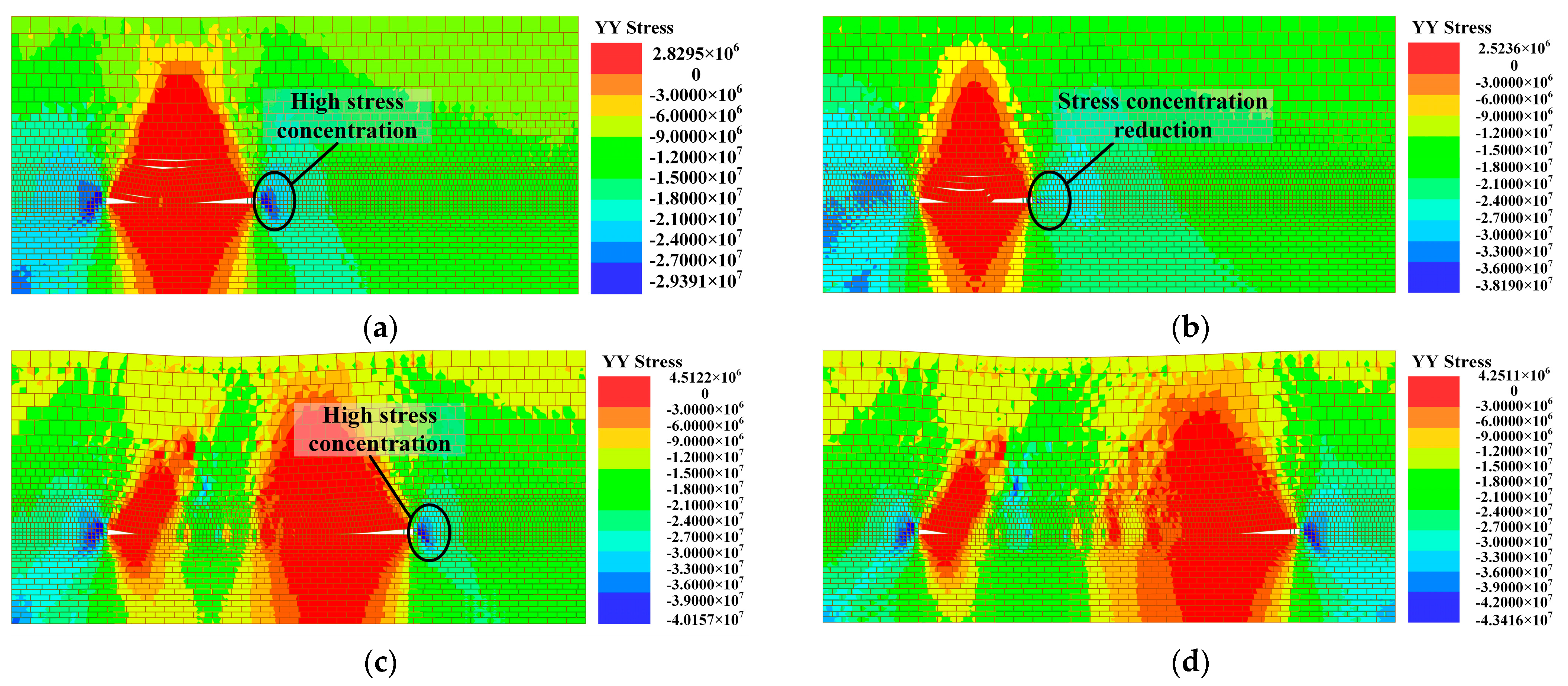



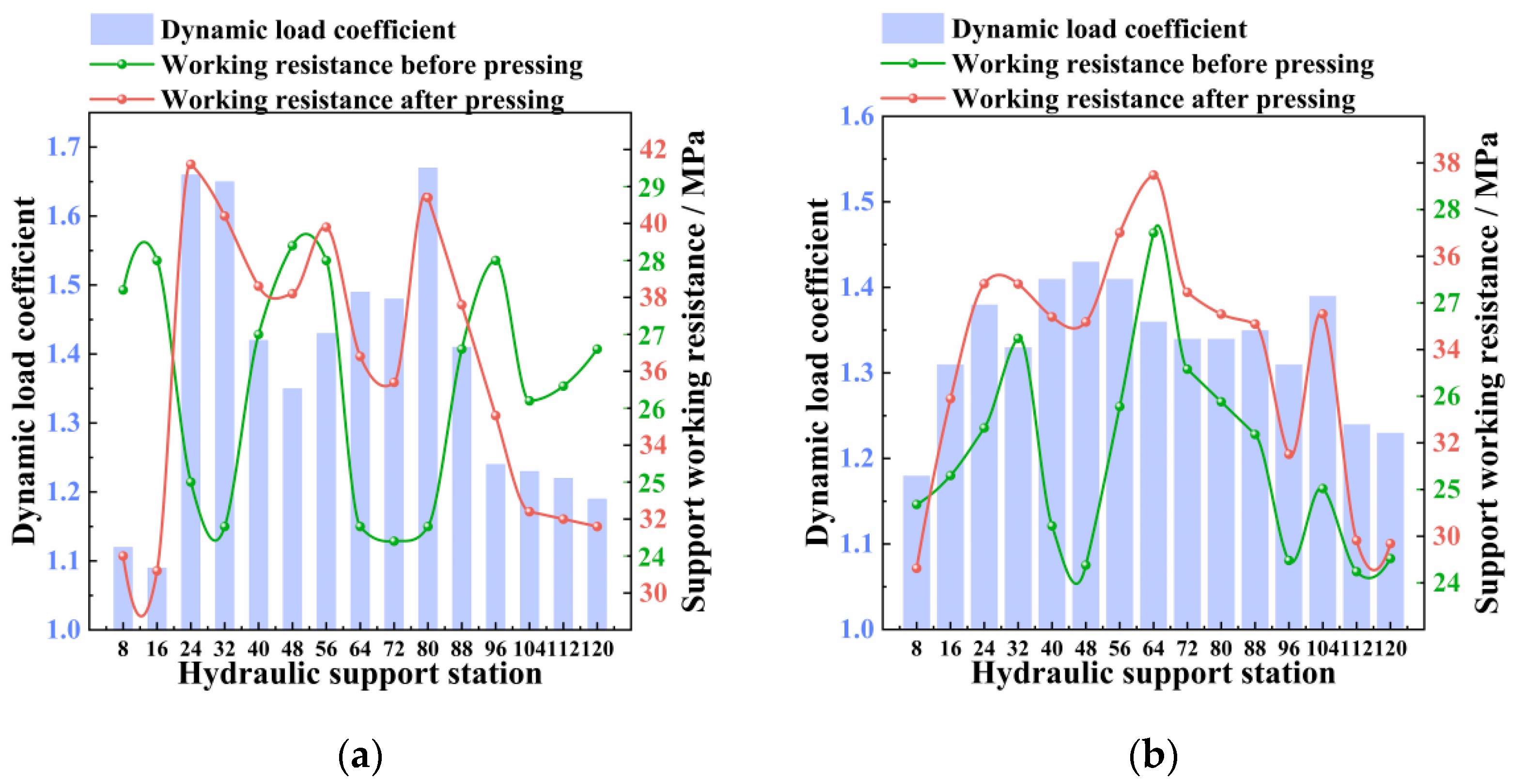
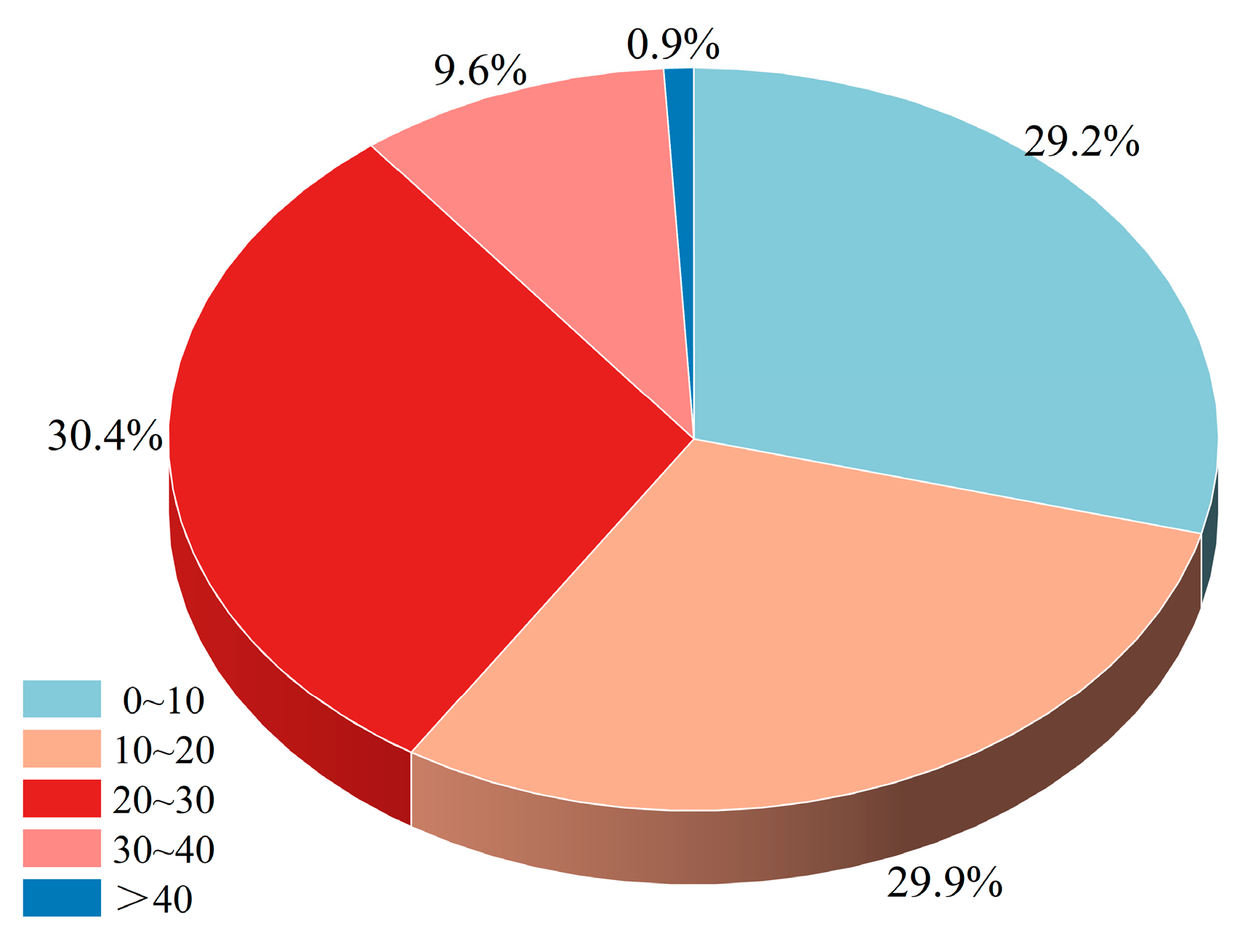
| Basic Top Classification | Appearance of Basic Top Pressure | Grading Index | |
|---|---|---|---|
| Level I | Not obvious | Pe ≤ 895 | |
| Level II | Obvious | 895 < Pe ≤ 975 | |
| Level III | Strong | 975 < Pe ≤ 1075 | |
| Level IV | Very strong | Level IVa | 1075 < Pe ≤ 1145 |
| Level IVb | Pe > 1145 | ||
| Lithology | H (m) | γ (kN/m3) | φ (°) | E (GPa) | σb (MPa) |
|---|---|---|---|---|---|
| Medium sandstone | 8.2 | 26.2 | 31° | 24 GPa | 6.50 MPa |
| Sandy mudstone | 1.7 | 25.6 | 29° | 11 GPa | 2.47 MPa |
| Fine sandstone | 6.2 | 26.8 | 36° | 29 GPa | 7.21 MPa |
| Sandy mudstone | 5.2 | 25.6 | 29° | 11 GPa | 2.47 MPa |
| Fine sandstone | 11.6 | 26.8 | 36° | 29 GPa | 7.21 MPa |
| Upper coal seam | 3.8 | 14 | 20° | 1 GPa | 2.00 MPa |
| Lower coal seam | 4 | 14 | 20° | 1 GPa | 2.00 MPa |
| Sandy mudstone | 2.3 | 25.6 | 29° | 11 GPa | 2.47 MPa |
| Silty sand rock | 5.4 | 26.1 | 33° | 24 GPa | 6.20 MPa |
| Siltstone | 7.2 | 26.7 | 33° | 25 GPa | 6.60 MPa |
| Station No. | 1 | 2 | 3 | 4 | 5 | 6 | 7 | 8 | 9 | 10 | 11 | 12 | 13 | 14 | 15 |
| Support No. | 8 | 16 | 24 | 32 | 40 | 48 | 56 | 64 | 72 | 80 | 88 | 96 | 104 | 112 | 120 |
| Working surface area | Upper part of working face | Middle of working face | Lower part of working face | ||||||||||||
| Monitoring Position | Support No. | Working Face Retreat/m | Remarks |
|---|---|---|---|
| Upper part of working face | 8 | 31.1 | Kerf width 8.5 m |
| 16 | |||
| 24 | |||
| 32 | |||
| 40 | |||
| Middle of working face | 48 | 32.6 | |
| 56 | |||
| 64 | |||
| 72 | |||
| 80 | |||
| Lower part of working face | 88 | 33 | |
| 96 | |||
| 104 | |||
| 112 | |||
| 120 | |||
| Initial pressure step | 40.8 | ||
Disclaimer/Publisher’s Note: The statements, opinions and data contained in all publications are solely those of the individual author(s) and contributor(s) and not of MDPI and/or the editor(s). MDPI and/or the editor(s) disclaim responsibility for any injury to people or property resulting from any ideas, methods, instructions or products referred to in the content. |
© 2023 by the authors. Licensee MDPI, Basel, Switzerland. This article is an open access article distributed under the terms and conditions of the Creative Commons Attribution (CC BY) license (https://creativecommons.org/licenses/by/4.0/).
Share and Cite
Li, J.; Fu, B.; Zhang, H.; Zhao, Q.; Bu, Q. Study on Fracture Behavior of Directly Covered Thick Hard Roof Based on Bearing Capacity of Supports. Appl. Sci. 2023, 13, 2546. https://doi.org/10.3390/app13042546
Li J, Fu B, Zhang H, Zhao Q, Bu Q. Study on Fracture Behavior of Directly Covered Thick Hard Roof Based on Bearing Capacity of Supports. Applied Sciences. 2023; 13(4):2546. https://doi.org/10.3390/app13042546
Chicago/Turabian StyleLi, Jiawen, Baojie Fu, Hualei Zhang, Qingchong Zhao, and Qingwei Bu. 2023. "Study on Fracture Behavior of Directly Covered Thick Hard Roof Based on Bearing Capacity of Supports" Applied Sciences 13, no. 4: 2546. https://doi.org/10.3390/app13042546
APA StyleLi, J., Fu, B., Zhang, H., Zhao, Q., & Bu, Q. (2023). Study on Fracture Behavior of Directly Covered Thick Hard Roof Based on Bearing Capacity of Supports. Applied Sciences, 13(4), 2546. https://doi.org/10.3390/app13042546




